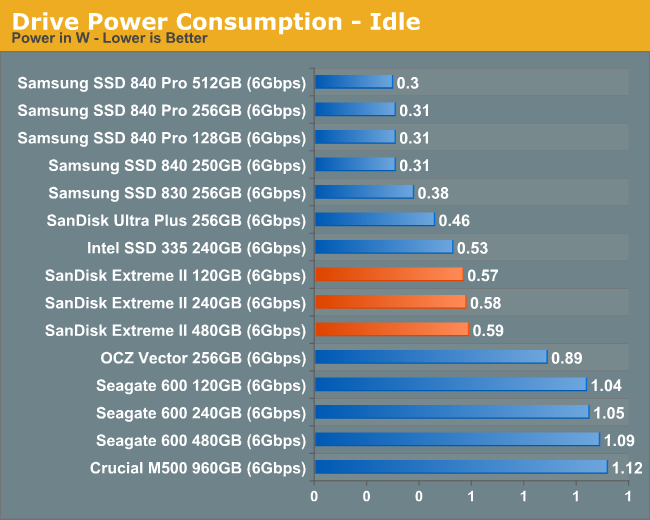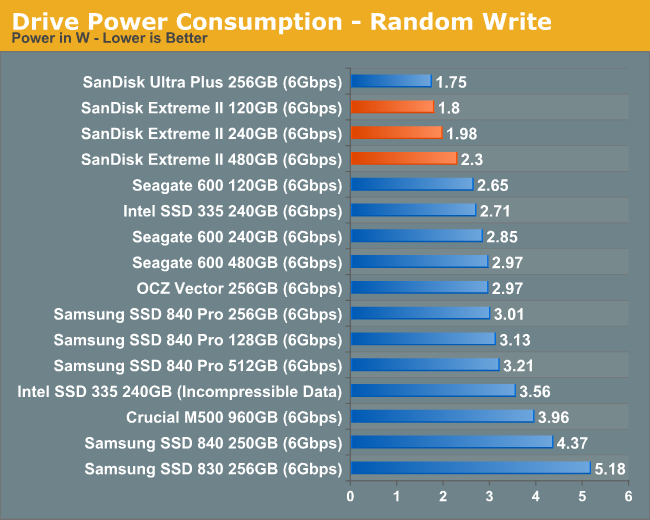SanDisk Extreme II Review (480GB, 240GB, 120GB)
by Anand Lal Shimpi on June 3, 2013 7:19 PM ESTPower Consumption
We're introducing a new part of our power consumption testing with this review: measurement of slumber power with host initiated power management (HIPM) and device initiated power management (DIPM) enabled. It turns out that on Intel desktop platforms, even with HIPM and DIPM enabled, SSDs will never go into their lowest power states. In order to get DIPM working, it seems that you need to be on a mobile chipset platform. I modified an ASUS Zenbook UX32VD to allow me to drive power to the drive bay from an external power supply/power measurement rig. I then made sure HIPM+DIPM were enabled, and measured average power with the drive in an idle state. The results are below:

Samsung does amazingly well in this test, with only Intel's first generation X25-M SSD coming anywhere close. The SanDisk drives do alright here, although they're a bit more power hungry than some of the others the differences aren't large enough to meaningfully impact most notebook usage. The important thing to note is just how bad power consumption can get if your drive doesn't properly support HIPM and DIPM. It's when you start getting into the 500mW - 1000mW range that you'll see real impacts to notebook battery life.
Our traditional idle power test is still useful as this is representative of power consumption in an active idle state. The lowest power states do take time to get in/out of, so if you're actively using your machine you may see some time spent in a non-slumber idle state which is effectively the data you see below:

Once again, the Extreme II does alright here. Idle power consumption isn't high enough to be a problem for notebook users, it's just not low enough to be as good as Samsung.
Under load the story is a little different. Peak sequential IO power consumption is very Samsung-like, but power consumption with a random write workload is amazingly low. I suspect this is a side effect of whatever SanDisk is doing to keep IO consistency in check.












51 Comments
View All Comments
dsumanik - Tuesday, June 4, 2013 - link
The benches on this drive are good.....not great, and I don think the opening bias is necessary. Who runs any disk at capacity 24/7? Perhaps some people temporarily... But 24/7 drive full???Only a fool.
Kudos to sandisk for making a competitive offering, but please anandtech keep the bias out of the reviews....specially when it's not warranted.
Storage bench is great, but it's not the only metric.
Haswell is good, not great. But if your rocking a 2600k from 2 years ago? Meh.
Where are the legendary power savings? Why don't we have 4 ghz + skus? 8 cores? 64gb ram support? Quick sync degraded lol!! Good job on iris pro. Why can't I buy it and slap it into an enthusiast board?
Yet you read this review and the haswell review and come away feeling positive.
Real life:
Intel,
A mild upgrade in IPC, higher In use TDP, 2 year old CPU's are still competitive
Sandisk,
Mixed bag of results, on unproven firmware.
.
Death666Angel - Tuesday, June 4, 2013 - link
Why do you keep ignoring the Samsung 840 Pro with spare area increased when it comes to consistency. It seems to me to be the best drive around. And if you value and know about consistency it seems pretty straight forward to increase the spare area and you should have the abilities to do so as well.seapeople - Wednesday, June 5, 2013 - link
Agreed, it looks like a Samsung 840 Pro that's not completely full would be the performance king in every aspect - most consistent (check the 25% spare area graphs!), fastest in every test, good reliability history, and the best all around power consumption numbers, especially in the idle state which is presumably the most important.Yet this drive is virtually ignored in the review, other than the ancillary mention in all the performance benchmarks it still wins, "The SanDisk did great here! Only a little behind all the Samsung drives... and as long as the Samsung drives are completely full, then the SanDisk gets better consistency, too! The SanDisk is my FAVORITE!"
The prevailing theme of this review should probably be "The SanDisk gives you performance nearly as good as a Samsung at a lower price." Not, "OMG I HAVE A NEW FAV0RIT3 DRIVE! Look at the contrived benchmark I came up with to punish all the other drives being used in ways that nobody would actually use them in..."
Seriously, anybody doing all that junk with their SSD would know to partition 25% of spare area into it, which then makes the Samsung Pro the clear winner, albeit at a higher cost per usable GB.
FunBunny2 - Tuesday, June 4, 2013 - link
To the extent that "cloud" (re-)creates server-dense/client-thin computing, how well an SSD behaves in today's "client" doesn't matter much. Server workloads, with lots o random operations, will be where storage happens. Anand is correct to test SSDs under loads more server-like. As many have figured out, HDD in the enterprise are little different from consumer parts. "Cloud" vendors, in order to make money, will segue to "consumer" SSD. Thus, we do need to know how well they behave doing "server" loads; they will in any case. Clients will come with some amount flash (not necessarily even on current file system protocols).joel4565 - Tuesday, June 4, 2013 - link
Any word on whether this drive will be offered in a 960 GB capacity for a reasonable price in the near future?This looks like the best performing drive yet reviewed, but I doubt I will see that big of difference from my 120 GB Crucial M4 in day to day usage. I really don't think most of us will see a large difference until we go to a faster interface.
So unless this drastically change in the next few months, I think my next drive will be the Crucial M500 960GB. Yes it will not be as consistent or quite as fast as the SanDisk Extreme II, but I won't have to worry about splitting my files, or moving steam games from my 7200 rpm drive to the SSD if they have long load times.
clepsydrae - Wednesday, June 5, 2013 - link
Question for those more knowledgeable: I'm building a new DAW (4770k, win 8) which will also be used for development (Eclipse in linux). Based on earlier anandtech reviews I ordered a 128GB 840P Pro for use as the OS drive and eclipse workspace directory and the like. Reading this article, i'm not sure if I should return the 840P for the SanDisk... the 840P leads it in almost all the metrics except the one that is the most "real-world" and which seems to mimic what I'll be using it for (i.e. Eclipse.)Opinions?
bmgoodman - Wednesday, June 5, 2013 - link
I gave up on SanDisk after they totally botched TRIM on their previous generation drive. They did such a poor job admitting it and finally fixing it that it left a bad taste in my mouth. They'd have to *give* me a drive for me to try their products again.samster712 - Friday, June 7, 2013 - link
So would anyone recommend this drive over the 840pro 256? Im very indecisive about buying a new drive.Rumboogy - Thursday, July 11, 2013 - link
Quick question. You mentioned a method to create an unused block of storage that could be used by the controller by creating a new partition (I assume fully formatting it) and then deleting it. This assumes TRIM marks the whole set of LBAs that covered the partition as being available. What is the comparable procedure on a Mac? Particularly if you don't get TRIM by default. And if you do turn it would it work in this case? Is there a way to guarantee you are allocating a block of LBAs to non-use on the Mac?pcmax - Monday, August 12, 2013 - link
Would have been really nice to compare it to their previous gen the Extreme I?